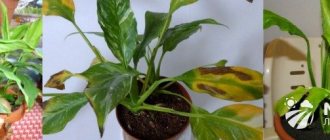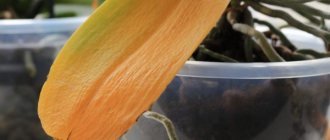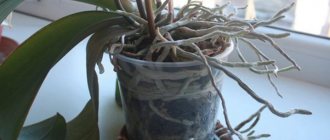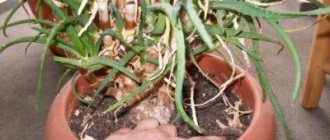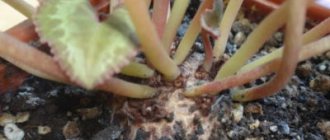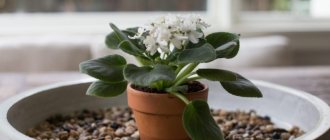Why do cyclamen leaves turn yellow - reasons
The main reason for yellowing of cyclamen leaves is non-compliance with agrotechnical conditions for growing the ornamental crop.
Reasons influencing the change in color of cyclamen foliage:
- Failure to comply with temperature conditions. You should know that cyclamen is a cold-loving plant, so it will not grow in too hot a room. For comfortable keeping, it is necessary to maintain the temperature at +14-16°C.
- Lack of natural light. If a flower pot is located at the back of the room, the plant will suffer from lack of light.
- Improper watering and excessive soil moisture. Dry indoor air can cause foliage to turn yellow. In addition, excessive waterlogging of the soil, as well as its drying out, also negatively affects the foliage.
- Incorrect application of fertilizers. Excessive application of nitrogen-containing fertilizers can lead to yellowing of leaf blades.
- No rest period. Cyclamen needs rest after long and abundant flowering. Many housewives try to prolong the flower's wakefulness, thereby disrupting the biological rhythm. When the flower is preparing for a period of rest, the cyclamen leaves turn yellow and wither. This is a normal natural process.
- Incorrect transplant. Cyclamen should be replanted before flowering.
- Pests. Insects annoy the plant, suck out the juices and the foliage turns yellow.
If you water the flower incorrectly, a disease such as gray rot may develop. First, the above-ground part withers, and then the tuber.
Cyclamen leaves turned yellow
The leaves turn yellow and wither if the cyclamen is attacked by pests, or if it does not have enough sunlight at a high temperature. The reason may be low air humidity.
If cyclamen grows in shade or partial shade and its leaves turn yellow, then the cause is a lack of sunlight. Experts recommend placing the flower in spring and autumn on windows that are oriented to the east. In winter, south-facing windows work well. Bright, diffused lighting is an important condition for growing cyclamen. However, direct sunlight can cause burns on the plant. It is also recommended to provide cyclamen with artificial lighting using a fluorescent lamp or ice lamp.
The leaves turn yellow and wither if the cyclamen is in a stuffy room where there is poor air circulation. Carbon monoxide and tobacco smoke can harm the flower. The plant needs a regular supply of fresh air. However, placing it under an open window in winter is prohibited, since cold air currents can destroy the flower. The leaves also turn yellow and the flowers wither if the cyclamen is kept in too warm a room. The optimal temperature for it is +12…+17 degrees. If the leaves of the cyclamen turned yellow after flowering in the period from March to May and this happened slowly, the tuber remained elastic and healthy, the cyclamen went to rest.
Very often, inexperienced gardeners buy a weak or diseased plant in a store. In most cases, it does not last long at home. Immediately after flowering it dies. The only way to save a purchased, diseased flower is to send it to rest, but again only if the tuber and root system of the plant remain intact. Healthy cyclamen produces abundant flowers and lots of green leaves.
I share my personal experience of growing cyclamen from seeds at home.
If the leaves of a cyclamen turn yellow, then the flower is too hot; for example, it can be kept in winter at a temperature of +20 degrees and above . At the same time, the room has a low level of air humidity. Comfortable conditions for keeping the plant +12…+17 degrees. If the temperature is higher, the cyclamen sheds its leaves and buds. To fix everything, you need to move the flower to a cool room, increase the air humidity there and organize artificial lighting.
What to do if cyclamen leaves turn yellow and wither
If the plant's leaf blades turn yellow and the leaves wither, it is first recommended to reconsider the conditions of maintenance.
It is necessary to properly water and maintain humidity in the room. When the plant begins to bloom, watering should be regular and moderate. To increase the humidity level, spray water from a fine spray bottle near the plant. It is important to ensure that water does not get on the vegetative parts of the plant.
Why do cyclamen leaves turn yellow during flowering, although there are no visible signs of waterlogging? It could be pests. In case of pest invasion, the plant is treated with insecticides or acaricides, diluting the working solution in accordance with the instructions.
Be careful!When buying fertilizers for cyclamen, it is important to look at the composition. The amount of nitrogen should be minimal! |
Cyclamen leaves wither
Why do cyclamen leaves wither? Leaves and buds wither if the cyclamen goes to rest, from an excess of moisture in the soil or from a lack of water. All problems with the photo are described in detail below.
Cyclamen leaves wither and turn yellow if the plant begins a dormant period . If cyclamen is put to rest, then its leaves wither gradually. This happens in early June, sometimes in mid-July, when the temperature in the room where the flower is located rises above +20 degrees. New leaves no longer grow, neither do buds. Old leaves begin to gradually wither and turn yellow. The plant is placed in a dark, cool place with good ventilation. You need to remember that for cyclamen that was recently purchased, the dormant period can begin at any time. The explanation is simple: the flower’s life rhythm may be disrupted, and therefore one should not be surprised if a new flower begins to gather for rest in the middle of winter.
Read more about how cyclamen goes to rest.
If the leaves and flowers wither en masse, the cyclamen is sick . Many new gardeners mistakenly assume that the plant has retired. But that's not true. Cyclamen prepares for dormancy gradually. If it suddenly drops its leaves, this indicates problems with the root system. It can rot from improper watering. Watering should be carried out only after the top layer of soil has dried. Top watering only. Bottom watering is not suitable here. There is a high probability of soaking the bottom layer of soil, which leads to rotting of the tuber. If a cyclamen tuber rots, it is removed from the soil and inspected. If it is slimy and the roots are flabby and brown, the flower cannot be saved. If the tuber is elastic and the roots are flabby, the latter are removed and the plant is allowed to rest.
Cyclamen leaves wither if the plant lacks moisture. The flower is watered after the top layer of soil has dried. Timely watering is important if the plant is kept at temperatures above +20 degrees. In this case, you cannot wait until the soil in the pot dries completely. Cyclamen grows and develops well with moderate soil moisture in the pot and air.
Why does cyclamen turn yellow and wither after purchase?
If cyclamen begins to turn yellow after purchase, it is most likely that the rules of care and maintenance were violated. It is possible that when moving to a new place of residence, the flower received stress, as there was a change in temperature and humidity levels.
The cause of yellowing foliage can be exhaustion. To sell as many specimens as possible, manufacturers use special biostimulants and hormone-based preparations to accelerate growth and flowering.
When purchasing, you must inspect the flowerpot with the flower. The structure of the soil should be uniform, there should be no mold or wilted leaves on the surface. The foliage also needs to be checked - turn it over and make sure that there are no cobwebs or other pests on the reverse side. The leaves should be even and smooth, not curled.
Why do cyclamen leaves turn yellow in winter?
Lack of proper care will result in the cyclamen having yellowed leaves hanging sullenly from the pot instead of green, lush foliage.
For normal development and flowering, cyclamen requires a temperature within +16°C. If the flower pot is located on a windowsill, under which there are heating radiators, you should take it into a cool room.
It is also recommended to pay attention to the light level. It is important that the indoor flower is not exposed to direct sunlight, otherwise the leaves will get burned and become limp. If the cyclamen does not have enough light, it is necessary to organize additional lighting.
How to save?
You can try to save the plant by taking the following emergency measures:
- Change the location of the potty. Move it to another room where the conditions are up to standard.
- Spray the butterfly flower with a stimulant. Usually this may be necessary after purchasing a flower and adapting it to new conditions.
- Add additional fertilizer to the cyclamen pot.
- If you see an obvious disease or notice pests, then dig up the tuber, free it from the remaining soil and replant the flower in good fertilized soil.
- The leaves can be treated with a medicine that is used to control pests. To have a positive effect, do this several times after a certain number of days. Approximately every 3-5 days.
Read about how to save cyclamen if it dies here.
Errors in care
Mistakes made by amateur gardeners often lead to irreversible consequences - cyclamen leaves turn yellow and wither.
Incorrect transplant
Failure to follow the rules of replanting: choosing the wrong time, too large a pot, incorrectly composed substrate - lead to the fact that the foliage of cyclamen turns yellow.
It is necessary to replant the flower after the dormant period ends. At this time the growing season begins.
For your information!Replanting a flower should not be done during flowering! Cyclamen can drop its buds, and subsequent flowering will be poor. Only the presence of urgent reasons can facilitate a transplant. |
The new pot for replanting should be a couple of centimeters larger than the previous one. It is recommended to choose a wide, but not deep container. Soil is poured into the prepared pot, which includes: turf and leaf soil, humus, sand.
The tuber of the European cyclamen should be completely immersed in the soil, the Persian - only half.
Rest period
European cyclamen does not have a dormant period, so it should not shed its leaves. In preparation for the dormant period, Persian cyclamen gradually sheds all its green mass.
Incorrect temperature
Too high an air temperature can cause leaf fall. A comfortable temperature for keeping cyclamen should not exceed +18°C during the day, and at night – not lower than +10°C. If the indoor plant is kept in a cool room, the flowering period will be longer.
Incorrect lighting
For flowering, cyclamen should have good lighting. In winter, you can place a pot with a flower on the windowsill on the east side, and in summer - on the north.
Humidity
The foliage can turn yellow either from a lack of moisture or due to waterlogging of the earthen clod. High humidity leads to rotting of the tuber. The root system, which has begun to rot, stops supplying nutrients to the vegetative part, so the leaves turn yellow.
On a note!Cyclamen should be watered only after the top layer of soil in the pot has completely dried. |
The frequency of watering is affected by the life cycle of the plant. During the dormant period, rare watering is necessary; during flowering, frequent but moderate watering is required.
Causes
As a rule, caring for cyclamen is simple, but sometimes a plant in a pot has a somewhat unsightly appearance. This could happen for many reasons and if action is not taken, the flower may die. The answer to the question “why does the plant die?” may have a wide variety of variations.
If you notice that cyclamen has dropped its leaves and withered, then the reasons for this condition may lie in the following:
- if such symptoms appeared after the pot was brought into the house, this means that the plant is under stress. This situation develops if the flowers were exposed to different growing conditions (for example, the wrong humidity or air temperature);
- exhaustion. The flower needs to be fed at certain periods (before budding and during the active growth stage). At this time, proper nutrition is needed through the application of fertilizers. If this is not done, the leaves will become limp;
- entering the resting stage. After the buds have bloomed, the cyclamen enters a dormant stage. The transition to this stage is characterized by the leaves withering. Many novice gardeners believe that the flowers die and throw them in the trash.
In addition, very often plants wither due to improper care. For example, cyclamen dies from excess moisture or temperature imbalance. Any deviation from standard care leads to the leaves drooping and withering.
Cyclamen are very demanding on the water regime, as well as the water with which they are watered. Here you need to use only soft and well-settled water. Moreover, it should be at room temperature. You also need to make sure that the air in the room is slightly humidified.
Separately, it is worth noting the fact that cyclamen does not tolerate an excess of salts in the soil. Excessive use of mineral fertilizers can lead to this condition. That is why, even if the care was correct at first glance, the flowers on the windowsill may look limp. But cyclamen does not always fade due to improper care. Very often, various diseases lead to this condition.
Diseases
The active growth phase is observed in winter. Since it is not always possible to create suitable conditions in winter, the plant becomes susceptible to various diseases.
Gray rot
The fungal disease is activated and actively spreads as a result of water entering the center of the plant. Spread is facilitated by an unventilated room. The fungus first covers the base of the stem and then actively moves upward.
To get rid of the disease, you will need to clean the plant from rotten leaves and move the pot to a well-ventilated room. If gray rot has spread to more than half of the flower, there is no point in resuscitating it.
To ensure fresh air flow, you can install a fan in the room. When watering, it is important to ensure that water does not get into the middle of the tuber.
For prevention purposes, you can use wood ash or the drug “Fitosporin”. Watering the soil with a solution of the drug can destroy pathogenic microorganisms.
Fusarium rot
The disease can destroy the plant. The root system is the first to suffer from fusarium rot. Then the rot spreads to the green mass.
It is very rarely possible to save a plant infected with fusarium. If the cyclamen dies, you will have to throw away everything - both the soil and the pot. The container should not be thrown away, but thoroughly disinfected and only then used for planting other plants.
For your information!The development of the disease is influenced by high air temperature along with high humidity. Even a new substrate may contain Fusarium rot bacteria, but they are activated only in moist soil. |
The disease is accompanied by yellowing of the foliage - these are the main symptoms. To confirm your guesses, it is recommended to free the flower from the ground and evaluate the condition of the root system. If doubts are confirmed, you can still cut the tuber. A sign of the disease is tissue discoloration. This is a signal to destroy the diseased specimen.
Pests
An invasion of pests can cause yellowing of the foliage of the Alpine violet. Cyclamen is overly susceptible to various types of pests, which are sometimes not so easy to fight, especially when there are small children and animals in the house.
Thrips
The most harmful and annoying insects with a small body size. Pests are difficult to detect. Thrips feed on plant sap and are located on the underside of the leaf. Rot develops in areas affected by thrips.
The difficulty in dealing with thrips lies in the fact that the insects are too nimble and move with lightning speed from one place to another.
If pests are not visible to the naked eye, they can be noticed by the main signs: falling pollen from flowers, darkening of leaf blades along the edges, poor flowering and thin holes on the leaves.
In the fight against thrips, you can use Actellik. The substance is effective, but the smell is pungent. To ensure the effectiveness of the work done, the plants should be sprayed again after a week.
Aphid
Aphids - small insects cause great harm to indoor flowers. They are located on the underside of the leaves and feed on the sap of the plant. You can notice aphids by the result of their vital activity - their presence is evidenced by a sticky coating on the leaf blades, on which fungal diseases subsequently develop. The foliage curls, withers and falls.
A soap solution works well against aphids. If fungus is noticed on the affected areas, it is recommended to cut off these leaves and discard them.
"Fitoverm" is a good bioinsecticide, suitable for controlling various types of aphids.
Mite
The cyclamen mite affects not only cyclamens, but also other indoor plants, such as Saintpaulias. The damage from a tiny spider is enormous. If you look closely, the spider will certainly come into view. Ticks do not tolerate light, so they are located among the foliage. Increased dryness of indoor air promotes the appearance of pests.
Signs of a plant being damaged by the cyclamen mite: leaf blades become thinner, discolored, and curl. Dark spots appear on the leaves. The buds cannot open to their full potential, the flowers turn out shapeless and ugly.
To treat cyclamen against ticks, it is necessary to set the diseased specimen aside from healthy ones. Acaricides must be used to control ticks. The chemical has a detrimental effect only on adult individuals, so it is recommended to carry out treatment three times with an interval of 7 days. During this time, new individuals will emerge from the eggs, which will also die during re-treatment. By maintaining optimal humidity, you can prevent the appearance of mites on indoor flowers.
